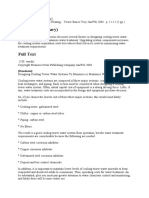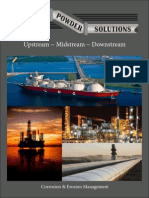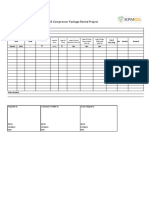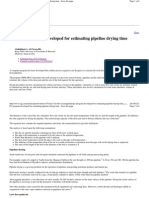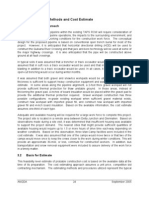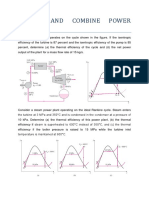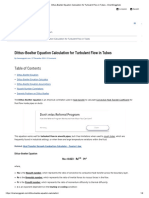Pipeline Drying
Pipeline Drying
Uploaded by
Ariel AnascoCopyright:
Available Formats
Pipeline Drying
Pipeline Drying
Uploaded by
Ariel AnascoOriginal Description:
Original Title
Copyright
Available Formats
Share this document
Did you find this document useful?
Is this content inappropriate?
Copyright:
Available Formats
Pipeline Drying
Pipeline Drying
Uploaded by
Ariel AnascoCopyright:
Available Formats
Application Notes
Pipeline Drying
Background
Process pipelines (and chemical vessels) which operate at elevated pressures need to be tested for the integrity of their construction and sealing at the time they are assembled. Periodic retesting is also required during usage. There are a number of methods of conducting this pressure test with the most common method being to seal the pipeline or vessel and pressurize with liquid water. Gas can be used to pressure test a vessel, but it is less commonly used because of its high compressibility which would be very dangerous if a leak or fracture developed in the pipeline. The problem with using water is that it leaves the pipeline wet after the test: This has two effects, first that the corrosion of the pipe or vessel will be accelerated and Sasol Refinery, South Africa second, that the process itself may well require the pipe or vessel to be dry. So it is common practice for the pipeline to be dried after the pressure test before it is put into operation.
Drying Methods
Three methods of drying the pipeline are commonly used, each of which can make use of a Kahn Ceramic Hygrometer.
1. Hot Air Drying
The pipeline is fed at one end with a supply of heated air from an air compressor. Heat energy is absorbed by the water in the pipeline which speeds evaporation. The water vapor is transported by the flowing air out of an exit port located at the opposite end of the pipe to the hot air entry. A capacitive instrument such as a Cermet II Hygrometer or Easidew Transmitter located at the air outlet will indicate completion of the drying process when the outlet air dewpoint reduces significantly from its starting value. During the process the air will be close to saturation at the prevalent ambient temperature. When the pipeline is dry, the dewpoint will reduce towards that of the feed air from the compressor.
An example of hot air drying
2. Nitrogen Purge Drying
Instead of using hot air, an inert purge gas such as nitrogen may be used. Two advantages of using nitrogen are that it will be very dry and therefore have a high capacity for water adsorption and also that it is inert and can be used to prepare pipelines or process vessels that will later contain explosive or flammable gases. The same procedure is used as in hot air drying above, often with comparison of feed minus outlet gas dewpoint being the measurement which determines the dryness of the pipeline. It is common for a differential of 10F dewpoint to be used as the signal for the end of the drying process.
An example of nitrogen purge drying
Application Notes
3. Vacuum Drying
In this method the pipeline is completely sealed and then a single port is connected to high power vacuum system, which extracts air from the pipeline. Over a period of time, the humidity level in the outlet will reduce rapidly as a stable vacuum level is formed. There will be a period where the dewpoint level stabilizes as residual liquid water is evaporated and extracted. When all the water has been removed, the dewpoint will drop again and this signals the end of the vacuum purge process. A single Easidew or Cermet II Sensor mounted in the vacuum inlet will give rapid determination of the end point. In any of the above applications, the Cermax or HygroPort Portable Hygrometer may be used if the operator needs to make spot measurements or compare drying performance at various locations.
An example of vacuum drying
WARNING: Pipeline drying applications can easily damage any moisture sensors. Filtration is strongly recommended as is only exposing the sensors to gas towards the end of the drying process.
Kahn Instruments, Inc. 885 Wells Road Wethersfield, CT 06109 Tel: 860-529-8643 Fax: 860-529-1895 Email: info@kahn.com Web: www.kahn.com
You might also like
- Pipe Problems & Elements (With Answer and Solution)Document36 pagesPipe Problems & Elements (With Answer and Solution)Lourence Arazo Enanod55% (11)
- 1 s2.0 S1364032116309534 MainDocument14 pages1 s2.0 S1364032116309534 Main180763119046.arvindNo ratings yet
- Purging Natural Gas Installation Volumes Between 0.03 M To 1.0 MDocument9 pagesPurging Natural Gas Installation Volumes Between 0.03 M To 1.0 MmetroroadNo ratings yet
- High-Performance Condenser Tube Cleaning System Featuring Advanced Ball Collecting Technology - r2005 - 03 - 104 PDFDocument5 pagesHigh-Performance Condenser Tube Cleaning System Featuring Advanced Ball Collecting Technology - r2005 - 03 - 104 PDFnur hamzahNo ratings yet
- Vacuum Drying TheoryDocument5 pagesVacuum Drying TheoryShishir Koyare100% (1)
- Toluene Solubility in Water and Organic Partitioning From Gasoline and Diesel Fuel Into Water at Elevated Temperatures and PressuresDocument6 pagesToluene Solubility in Water and Organic Partitioning From Gasoline and Diesel Fuel Into Water at Elevated Temperatures and PressuresDiogomussumNo ratings yet
- Practise Questions 2019Document8 pagesPractise Questions 2019Sehar IshtiaqNo ratings yet
- Air Blow CleaningDocument5 pagesAir Blow CleaningTaher MassahNo ratings yet
- Pipeline DryingDocument2 pagesPipeline DryingAdan Farias de PinaNo ratings yet
- Factors Contributing To Foarming Crude OilDocument11 pagesFactors Contributing To Foarming Crude OilSang Duong Van100% (1)
- Cooling WaterDocument4 pagesCooling WaterChristian SusantoNo ratings yet
- Compressor WashingDocument7 pagesCompressor Washingsamil68100% (1)
- Best Blackpowder2013Document24 pagesBest Blackpowder2013sohail1985No ratings yet
- III Nanaware Iocl PresentationDocument33 pagesIII Nanaware Iocl PresentationAnonymous kbPP3CCcNo ratings yet
- Coral FLNG SA Is The Special Purpose Entity Responsible To Develop and Operate Coral South Floating Platform (FLNG)Document4 pagesCoral FLNG SA Is The Special Purpose Entity Responsible To Develop and Operate Coral South Floating Platform (FLNG)MateusPauloNo ratings yet
- Economically Viable Large-Scale Hydrogen Liquefaction PDFDocument9 pagesEconomically Viable Large-Scale Hydrogen Liquefaction PDFDilla WahabNo ratings yet
- HM50 4th Ed - Tank Cleaning Guide - For Cross ReferenceDocument32 pagesHM50 4th Ed - Tank Cleaning Guide - For Cross ReferenceNalin PrabhakarNo ratings yet
- LNG Pipeline SystemDocument46 pagesLNG Pipeline SystemfanhadNo ratings yet
- The Main Installations: 1. Degassing StationsDocument4 pagesThe Main Installations: 1. Degassing Stationsعمار ياسرNo ratings yet
- Integrated Assurance - Checklist DetailsDocument438 pagesIntegrated Assurance - Checklist DetailsSyed AhmadNo ratings yet
- SGGP Reference No: P0116-TAK-P01-0024-02Document11 pagesSGGP Reference No: P0116-TAK-P01-0024-02Jabel Oil Services Technical DPTNo ratings yet
- Hydrostatic Test ChartDocument10 pagesHydrostatic Test ChartAnanda ShofwanNo ratings yet
- Abondoned Pipeline Oil Recovery Procedure-00Document5 pagesAbondoned Pipeline Oil Recovery Procedure-00Tuesou MachereNo ratings yet
- SinoCleansky Mini-LNG Plant Inquiry Form 2019Document2 pagesSinoCleansky Mini-LNG Plant Inquiry Form 2019Almira CitraNo ratings yet
- LPG Pipeline MeteringDocument7 pagesLPG Pipeline MeteringDinesh Pinto100% (1)
- Shop Drawing - 500 GPM at 8 Bar EDJ UL Listed End Suction-For Prasoon-ModelDocument1 pageShop Drawing - 500 GPM at 8 Bar EDJ UL Listed End Suction-For Prasoon-ModelSooraj VsNo ratings yet
- 02 03 Design For Commisioning and Cleaning PDFDocument19 pages02 03 Design For Commisioning and Cleaning PDFwylie010% (2)
- Commissioning: Commissioning and Initial Start UpDocument3 pagesCommissioning: Commissioning and Initial Start Uplifemillion2847No ratings yet
- C-051-VP-040-CLTW-SCH-0006 REV-1 Code-A With Minor CommentsDocument5 pagesC-051-VP-040-CLTW-SCH-0006 REV-1 Code-A With Minor CommentsMidha NeerNo ratings yet
- Inspection and Test Plan 3L Polyethelene Coated Pipes: EPCC-06Document4 pagesInspection and Test Plan 3L Polyethelene Coated Pipes: EPCC-06sachinpsawantNo ratings yet
- Record of Oil Flush - KPMOG PDFDocument1 pageRecord of Oil Flush - KPMOG PDFCokro YudhaNo ratings yet
- K-VD-024102 - 202 Glycol Flash DrumDocument1 pageK-VD-024102 - 202 Glycol Flash Drumhicher lahcenNo ratings yet
- Chemical Cleaning and Steam Blowing Application Sheet Rev.1Document12 pagesChemical Cleaning and Steam Blowing Application Sheet Rev.1Eslam ShiblNo ratings yet
- Balance Line Purge Valve Vent 1 Pig Trap Isolation Valve Vent 2Document4 pagesBalance Line Purge Valve Vent 1 Pig Trap Isolation Valve Vent 2Rohit VermaNo ratings yet
- PIPING WORKS Gross Leak Test (PTJ-Lub-Growth II-COM-0010) Rev.0Document10 pagesPIPING WORKS Gross Leak Test (PTJ-Lub-Growth II-COM-0010) Rev.0Ahmed Al SharabasyNo ratings yet
- Truck Rail Loading SystemDocument5 pagesTruck Rail Loading SystemMitallNo ratings yet
- Hydrotest PipelineDocument9 pagesHydrotest PipelineShrichand G. BathvNo ratings yet
- Snoop Leak Test LiquidDocument6 pagesSnoop Leak Test Liquidaldi_crisNo ratings yet
- 9500-WGEL-S003-ISGP-G00000-MP-4306-00017 - 01A - MTO PFF - by LayoutDocument7 pages9500-WGEL-S003-ISGP-G00000-MP-4306-00017 - 01A - MTO PFF - by Layoutsuresh100% (1)
- HPCL Material Preservation GuidelinesDocument7 pagesHPCL Material Preservation GuidelinespaimpillyNo ratings yet
- Flowmaster Case Study Surge AnalysisDocument6 pagesFlowmaster Case Study Surge Analysisnaren_013100% (1)
- United States Department of The Interior: Mr. J.E. WardDocument20 pagesUnited States Department of The Interior: Mr. J.E. WardGrishworld ShanNo ratings yet
- Da and Dhda Datasheet Master - XLSM - Hpu-Dhda118-4.1 Rev1Document3 pagesDa and Dhda Datasheet Master - XLSM - Hpu-Dhda118-4.1 Rev1jujuroyaleNo ratings yet
- Start Up and Commissioning of Pipelines: D. S. Nanaware, Chief Project Manager, IOCL, NoidaDocument33 pagesStart Up and Commissioning of Pipelines: D. S. Nanaware, Chief Project Manager, IOCL, NoidaAndi SungNo ratings yet
- Pressure Tests of Piping SystemsDocument14 pagesPressure Tests of Piping SystemsharishcsharmaNo ratings yet
- PiggingDocument24 pagesPiggingJulio Cesar Galarza Lobo0% (1)
- Oil Pipeline Valve AutomationDocument12 pagesOil Pipeline Valve Automationhamza2085No ratings yet
- CESCO Technical ProposalDocument2 pagesCESCO Technical ProposalthmaraishriNo ratings yet
- Preservation Program Works For Outages From One Month To Several YearsDocument4 pagesPreservation Program Works For Outages From One Month To Several Yearse.vicente.caballeroNo ratings yet
- Erection Sequence of LNG TANKDocument29 pagesErection Sequence of LNG TANKronaldmus100% (3)
- Gas Hydrate Tutorial PDFDocument134 pagesGas Hydrate Tutorial PDFGinoNo ratings yet
- Pigging - Concept, Installation & Operations: Presenters: Uma Maheswar Gali & S. Chellasamy - Completions DepartmentDocument69 pagesPigging - Concept, Installation & Operations: Presenters: Uma Maheswar Gali & S. Chellasamy - Completions DepartmentARAVINDRAJ V R100% (2)
- Problematic Processes For Hot TappingDocument2 pagesProblematic Processes For Hot Tapping최승원No ratings yet
- Drying and Purging Procedure (PTJ-Lub-Growth II-COM-013) Rev.0Document13 pagesDrying and Purging Procedure (PTJ-Lub-Growth II-COM-013) Rev.0Ahmed Al SharabasyNo ratings yet
- Turret Swivel System Operation (Rev.00)Document12 pagesTurret Swivel System Operation (Rev.00)hai dang maiNo ratings yet
- LNG Receiving Terminals: BY CH - Satvika 16021A2545Document24 pagesLNG Receiving Terminals: BY CH - Satvika 16021A2545Ram Charan Konidela100% (2)
- Astm A312Document2 pagesAstm A312aezeadNo ratings yet
- Industrial Training Report Nitrogen PurgingDocument9 pagesIndustrial Training Report Nitrogen PurgingMuhammad FirdawsNo ratings yet
- Pipeline DryingDocument14 pagesPipeline DryingMAHESH CHANDNo ratings yet
- Pipeline DryingDocument2 pagesPipeline DryingZainal AbidinNo ratings yet
- PC Program Developed For Estimating Pipeline Drying Time: Save Article Instructions CloseDocument8 pagesPC Program Developed For Estimating Pipeline Drying Time: Save Article Instructions ClosescrbdgharaviNo ratings yet
- Aspects of Lead Acid Battery Technology 5 Dry Charging of Formed Negative PlatesDocument12 pagesAspects of Lead Acid Battery Technology 5 Dry Charging of Formed Negative PlatestjkiddNo ratings yet
- Module II Part CDocument32 pagesModule II Part Camyrb9088No ratings yet
- 1 SATIP-A-004-02 Hydro Test of Plant Piping-Rev 1Document2 pages1 SATIP-A-004-02 Hydro Test of Plant Piping-Rev 1Ariel Anasco50% (2)
- Method Statement For Carbon Steel U G Piping Fabrication ErectionDocument28 pagesMethod Statement For Carbon Steel U G Piping Fabrication ErectionAriel Anasco100% (1)
- Total: (Four Hundred Only) Aed 400.00Document1 pageTotal: (Four Hundred Only) Aed 400.00Ariel AnascoNo ratings yet
- Checklist 735 AWR 00001 99999 PM - 4 - METRICDocument10 pagesChecklist 735 AWR 00001 99999 PM - 4 - METRICAriel AnascoNo ratings yet
- Air Cooled ChillerDocument4 pagesAir Cooled Chilleraad_180No ratings yet
- 2 Marks Power Plant InstrumentationDocument18 pages2 Marks Power Plant InstrumentationVaishnavi SureshNo ratings yet
- Construction Methods and Cost EstimateDocument3 pagesConstruction Methods and Cost Estimatemerdin2kNo ratings yet
- Cam & Groove Couplings For Hose & Pipe: General DimensionsDocument2 pagesCam & Groove Couplings For Hose & Pipe: General DimensionsAriel AnascoNo ratings yet
- Erico 15 - Pipe Hanger & SupportDocument12 pagesErico 15 - Pipe Hanger & SupportFabio MiguelNo ratings yet
- Saes A 004Document17 pagesSaes A 004Broderick DispoNo ratings yet
- PIPE THREAD DimensionDocument2 pagesPIPE THREAD DimensionAriel AnascoNo ratings yet
- Types of Thermodynamic ProcessDocument8 pagesTypes of Thermodynamic ProcessSaranrajPachayappanNo ratings yet
- CHEM 1067 Lec 3 - 2019 - NJ - 4 PDFDocument21 pagesCHEM 1067 Lec 3 - 2019 - NJ - 4 PDFIbrahim AliNo ratings yet
- Problem 11 4 5Document10 pagesProblem 11 4 5Yahyah NahabooNo ratings yet
- P&id He 17.09.22Document1 pageP&id He 17.09.22MochammadRiz AttantoNo ratings yet
- Energy LabDocument3 pagesEnergy Labkrbfcbyc4vNo ratings yet
- Heat & EnergyDocument45 pagesHeat & EnergyImran UnarNo ratings yet
- Assignment 4 MSE201Document2 pagesAssignment 4 MSE201mauryashubhamiitkNo ratings yet
- Thermodymnamics Basic TermsDocument6 pagesThermodymnamics Basic TermsJoseCastilhoNo ratings yet
- Cooling Tower DesignDocument12 pagesCooling Tower DesignsenaNo ratings yet
- Vapour and Combine Power CyclesDocument4 pagesVapour and Combine Power CyclesKishore KrishNo ratings yet
- ETDocument525 pagesETAshok GovindharasuNo ratings yet
- SMEA1302Document94 pagesSMEA1302AZIZUR RAHMANNo ratings yet
- Af-S100rx Af-S120rx Af-S125rxDocument20 pagesAf-S100rx Af-S120rx Af-S125rxMohamed SaadAllahNo ratings yet
- Dittus-Boelter Equation Calculation for Turbulent Flow in Tubes - ChemEnggCalcDocument9 pagesDittus-Boelter Equation Calculation for Turbulent Flow in Tubes - ChemEnggCalcchemenggcalcNo ratings yet
- PSV For Super Critical FluidDocument10 pagesPSV For Super Critical FluidMubarik AliNo ratings yet
- Air To Air HX Ventilation SystemDocument12 pagesAir To Air HX Ventilation SystemGopinath GopiNo ratings yet
- Smoothed Particle Hydrodynamics Method For Two-Dimensional Stefan ProblemDocument9 pagesSmoothed Particle Hydrodynamics Method For Two-Dimensional Stefan ProblemvinnervickyNo ratings yet
- Bab 2 Baru Thermal TransducerDocument30 pagesBab 2 Baru Thermal TransducerjepriNo ratings yet
- Group 2 Experiment 2 Lab ReportDocument3 pagesGroup 2 Experiment 2 Lab ReportYassin BusarNo ratings yet
- Rate of Chemical Change KODocument3 pagesRate of Chemical Change KOAyesha RahmanNo ratings yet
- High Emissivity CoatingDocument12 pagesHigh Emissivity CoatingĐoàn TrangNo ratings yet
- Thermodynamics Part 3 NotesDocument52 pagesThermodynamics Part 3 NotesFrancis CometaNo ratings yet
- PP Chapter 5 Refrigeration Cycle Sem 2 2011-2012Document19 pagesPP Chapter 5 Refrigeration Cycle Sem 2 2011-2012Amuthan Shanmugum100% (1)
- Combined Convection and RadiationDocument8 pagesCombined Convection and RadiationZAVEN TORTIANNo ratings yet
- 6.thermal EngineeringDocument7 pages6.thermal EngineeringprasanthprpNo ratings yet
- Tatb HMX PBXDocument11 pagesTatb HMX PBXwyngo68No ratings yet
- Tutorial - Chapter 4 (Transient Conduction) : Wednesday 19/02/2019 Venue: K303Document3 pagesTutorial - Chapter 4 (Transient Conduction) : Wednesday 19/02/2019 Venue: K303YemukelaniNo ratings yet










